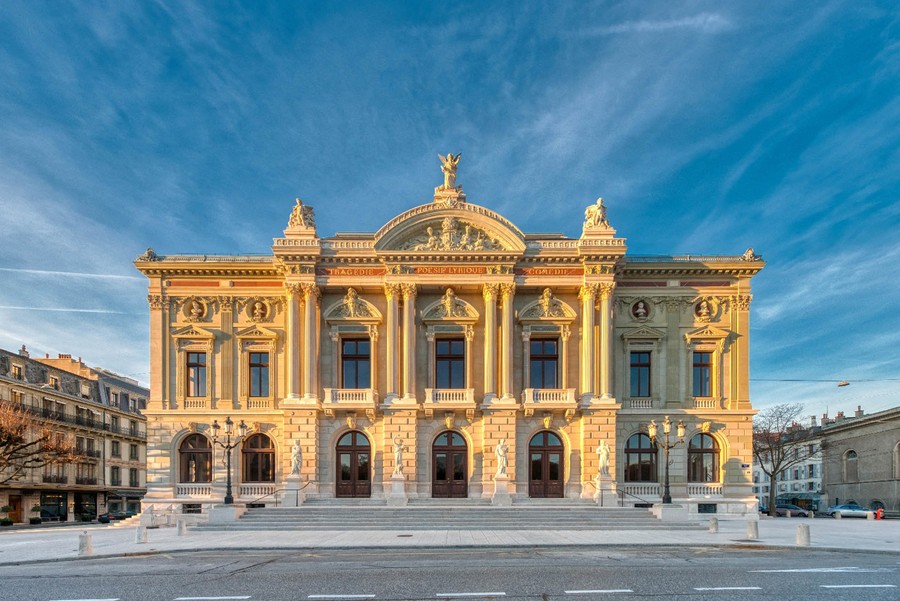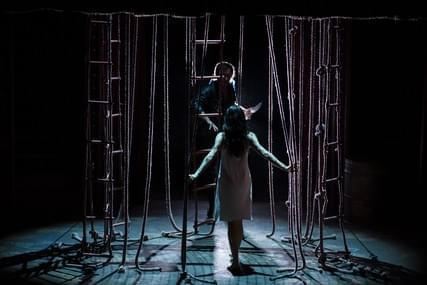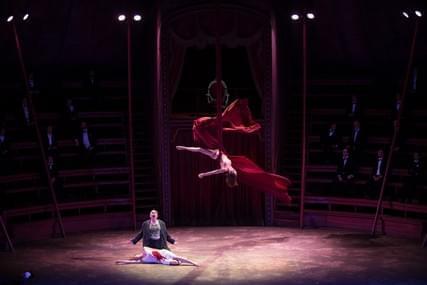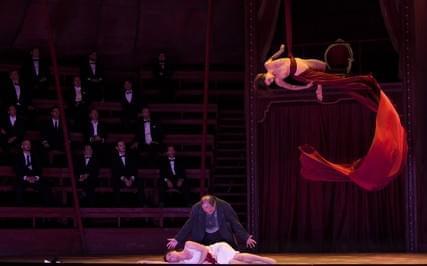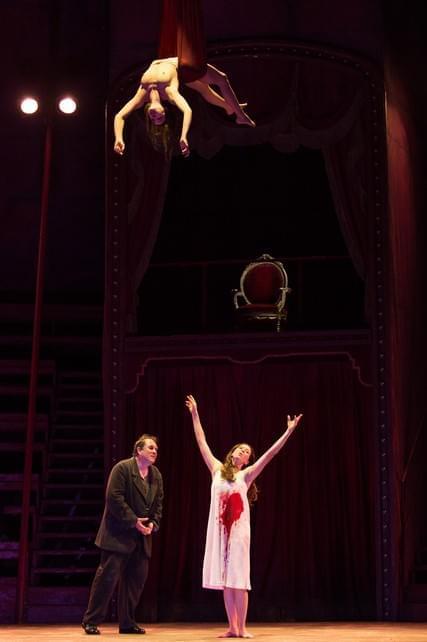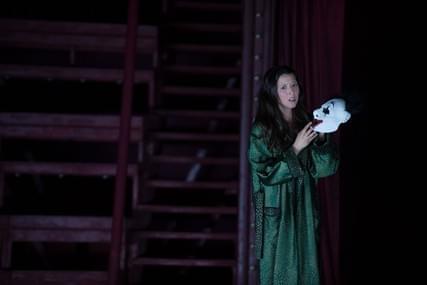Rigoletto
Music by
Giuseppe Verdi
Cast
| Duke of Mantua | Arnold Rutkowski | |
| Duke of Mantua | Georgy Vasiliev - Jun. 09 | |
| Rigoletto | Franco Vassallo | |
| Rigoletto | Andrzej Dobber - Jun. 09 | |
| Gilda | Lisette Oropesa | |
| Gilda | Sophie Gordeladze - June. 09, 16 | |
| Sparafucile | Sami Luttinen | |
| Maddalena | Ahlima Mhamdi | |
| Giovanna | Varduhi Khachatryan | |
| Count Monterone | Maxim Kuzmin-Karavaev | |
| Marullo | Michel de Souza | |
| Borsa | Fabrice Farina | |
| Count Ceprano | Daniel Mauerhofer | |
| Countess Ceprano | Marina Lodygensky | |
| Page | Marina Lodygensky | |
| Usher | Wolfgang Barta |
Alexander Joel
ProductionRobert Carsen
DirectorOlivier Fredj
Set DesignerRadu Boruzescu
CostumesMiruna Boruzescu
LightingPeter van Praet
ChoreographyPhilippe Giraudeau
DirectorIan Burton
About
“God knows that with a topic like this one, you can’t go wrong.” Giuseppe Verdi knew that by choosing a libretto based on Victor Hugo’s Le Roi s’amuse, he would be working with a rich and colourful subject matter. It also gave him the opportunity to make the musical portrait of one of the most charismatic figures in the history of opera. Rigoletto is the misshapen jester at the court of the Duke of Mantua and the father of Gilda, whom he cherishes more than any living thing. Despite the appalling nature of his acts, this modern hero, which Robert Carsen portrays as a clown straight out of the circus, also moves the audience with his deeper yearnings. When an ancient curse catches up with him, the hunchbacked jester that helps the Duke abduct young women is caught in his own trap, becoming both executioner and victim. A milestone in the artistic evolution of Verdi’s career, Rigoletto would be the first opera in his “Popular Trilogy”. Premiering in Venice in 1851, this melodramma raised the “Swan of Busseto” to the status of genius of Italian opera.
Orchestre de la Suisse Romande
Media
Avant le lever de rideau - Rigoletto
Reviews
Rigoletto, antihéros d’un cirque vicieux
Mais le moment de grâce absolue se niche sous les étoiles d’un ciel de rêve. Lorsque Gilda apparaît en trapéziste lunaire au-dessus de la roulotte paternelle. Lisette Oropesa offre là un exemple de chant aérien, dans une magnifique longueur de voix, aux nuances souples, à la musicalité fine et à l’humanité frissonnante. Un sommet du genre.But the moment of absolute grace is nestled under the stars of a dream sky. When Gilda appears as a lunar trapeze artist above her father's caravan. Lisette Oropesa offers here an example of airy singing, in a magnificent vocal register, with flexible nuances, fine musicality, and thrilling humanity. A pinnacle of the genre.— Sylvie Bonier • Le Temps
GENF/ Grand Théâtre de Genève: RIGOLETTO
Lisette Oropesa ist eine sehr koloratursichere, innig zarte Gilda, welche die Kantilenen gleichsam mit dem Silberstift zeichnet. Dabei kommt die Liebe zum Vater allerdings glaubhafter zum Ausdruck als die Leidenschaft für den Herzog die Gilda ihr Leben opfert. Sie gestaltet ihre grosse Arie im ersten Akt fein, als zurückgenommenen, lyrischen Monolog. Im dramatischen zweiten Teil, wo sie sich anstelle des Herzogs vom Meuchelmörder Sparafucile (sehr überzeugend: Sami Luttinen) ermorden lässt, begeistert die Sopranistin mit dramatischen Tönen.Lisette Oropesa is a very secure coloratura soprano, a deeply tender Gilda, who draws the cantilenas as if with a silver pencil. In this, the love for her father comes across more credibly than the passion for the Duke to whom Gilda sacrifices her life. She shapes her big aria in the first act finely, as a reserved, lyrical monologue. In the dramatic second part, where she lets herself be murdered by the assassin Sparafucile (very convincingly: Sami Luttinen) in place of the Duke, the soprano excites with dramatic tones.— Marcel Paolino • Online Merker
The Autumn Season Begins…
The standout, however, was Lisette Oropesa’s Gilda. The American soprano is a superb coloratura with ringing top notes. She displayed a strong sense of line which she used to convey all the sides of her character. Her evolution from an innocent young girl to a resolute woman was credible and moving. She brought the house down and deserved every second of it.None— Antoine Leboyer • Seen and Heard International
A Genève, Rigoletto ou la défaite de la femme
Le monde de Gilda, fait d’amour juvénile et pur, donne lieu à la plus émouvante des scènes. Le toit du chapiteau soudain constellé de mille étoiles voit Gilda s’élever du sol sur un trapèze et sa romance prendre alors une puissance émotionnelle extraordinaire. Qui mieux que Lisette Oropesa (Gilda) pouvait mettre le poids de l’or qu’elle possède dans sa voix pour faire vibrer cette sublime cantilène ? Un moment de grâce où la jeune soprano américaine offre une voix aux subtiles nuances. Quelle beauté de timbre, quelle intelligence d’interprétation, quel cœur, quel admirable chant. Donnant l’impression de chanter aux limites de sa voix, chacun retient son souffle de peur qu’elle ne trébuche, qu’elle soit emportée par l’émotion du moment, mais sous ces aspects de fragilité, on sent la force d’une chanteuse à la technique parfaite et à l’authenticité d’une artiste accomplie. Ce n’est qu’aux ultimes mesures de son air que la tension s’apaise et que le public, jusqu’ici assez tiède, laisse exploser sa joie et réserve un triomphe à cette exceptionnelle interprète.Gilda's world, made of pure and youthful love, gives rise to the most moving of scenes. The top of the big top, suddenly studded with a thousand stars, sees Gilda rising from the ground on a trapeze and her romance then taking on extraordinary emotional power. Who better than Lisette Oropesa (Gilda) could have put the weight of the gold she possesses in her voice to resonate this sublime cantilena? A moment of grace where the young American soprano offers a voice with subtle nuances. What a beautiful timbre, what a smart interpretation, what heart, what admirable singing. Giving the impression of singing at the limits of her voice, everyone holds their breath for fear she might stumble, that she might be swept away by the emotion of the moment, but beneath these seemingly fragile aspects, one can feel the strength of a singer with perfect technique, and the authenticity of an accomplished artist. It is only in the final measures of her aria that the tension eases and the audience, hitherto quite chilly, erupts in joy and reserves a triumph for this exceptional interpreter.— Jacques Schmitt • ResMusica
Performance History
Lisette has given 73 performances as Gilda.
2025
Arena di Verona
LA Opera2022
Metropolitan Opera
Wiener Staatsoper2021
Royal Opera House2018
Teatro dell'Opera di Roma
Arena di Verona
LA Opera2017
Opéra National de Paris
De Nationale Opera2016
Teatro dell'Opera di Roma2015
Teatro Real
Bayerische Staatsoper
Het Concertgebouw2013
Metropolitan Opera2008
Arizona Opera
New Orleans Opera

